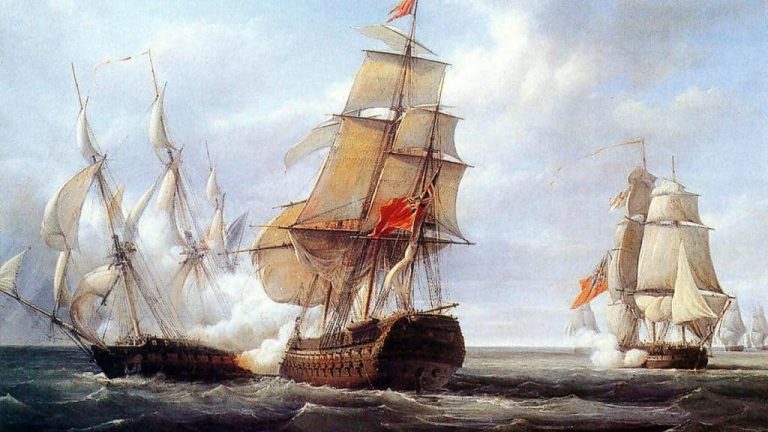Third Rate

During the period from April 9th to April 12th, 1782, a British fleet led by Admiral George Brydges Rodney engaged and defeated a French fleet commanded by the Comte de Grasse in the Battle of the Saintes. This victory thwarted the French’s plans to invade Jamaica. Rear-Admiral Sir Samuel Hood fought alongside Rodney during the battle but criticized his commander for not fully pursuing the retreating enemy fleet after the victory.
After the battle, the British fleet sailed to Jamaica, where Admiral Rodney instructed Hood to search for any disabled or damaged French ships that had managed to escape. Hood’s division, consisting of thirteen ships, set course towards Saint-Domingue.
Hood’s ships pursued the French vessels, utilizing their faster copper-sheathed hulls to outpace the damaged French ships. HMS Valiant successfully captured both Jason and Caton, albeit with the loss of four men killed and six wounded. Similarly, HMS Magnificent captured the frigate Aimable, at the cost of four killed and eight wounded. However, the frigate Astrée managed to escape with minimal damage.
The captured French ships were transported back to England for further use. Jason was renamed HMS Argonaut, while Caton was repurposed as a prisoner of war hospital ship, stationed off Saltash in Cornwall. It continued to serve in this capacity well into the Napoleonic Wars. Aimable was renamed HMS Aimable and remained in service with the Royal Navy until 1811.

In 1783, the ship was renamed HMS Argonaut. On January 8th, 1795, under the command of Captain Alexander John Ball, HMS Argonaut engaged in a battle with the French. Assisted by HMS Oiseau, they successfully captured the French sloop Esperance, which was armed with 22 guns (4 and 6-pounders) and had a crew of 130 men. Esperance had been at sea for 56 days from Rochefort, bound for the Chesapeake Bay, and was under the command of Lieutenant de Vaisseau De St. Laurent. The prize money from the capture was shared between HMS Argonaut and Captain Robert Murray’s HMS Oiseau.
Following the capture, the French ambassador to the United States lodged a complaint with the President of the United States, alleging that HMS Argonaut had violated a treaty between France and the United States by entering Lynnhaven Bay either before or shortly after capturing Esperance. The French also accused the British of bringing Esperance into Lynnhaven for refitting before continuing their cruise. The President forwarded the complaint to the Secretary of State, who in turn passed it on to the Governor of Virginia.
To investigate the matter, the Governor of Virginia sought information from the British Consul at Virginia. The Consul responded that the capture had occurred approximately 10 leagues offshore. Due to adverse weather conditions, HMS Argonaut and its prize sought shelter within the Chesapeake Bay for several days but departed as soon as it was feasible. Additionally, Argonaut had released its French prisoners upon entering Lynnhaven Bay, indicating that its sole purpose in entering American territorial waters was to parole the prisoners. The authorities in Virginia collected several testimonies but ultimately took no further action on the matter.
Because she was captured in good order and sailed well, Rear Admiral George Murray, the British commander in chief of the North American station, put a British crew aboard and sent Esperance out on patrol with Lynx on 31 January.
In 1797, she was reduced to harbour service and used as a Hospital Ship in the River Medway. Then, in 1822, she was moved a short distance upstream to Chatham and used in a similar role. Argonaut was eventually broken up in 1831.

